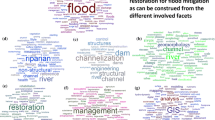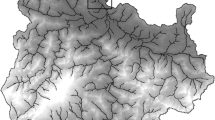Abstract
The environmental impact of loss of natural stream and riparian habitat is of concern throughout the United States and Europe. Environmental impacts related to such activities as channelization of and levee construction along streams and rivers are particularly apparent in the Midwestern United States. The objective of the research presented here was to delineate the extent, relative degree of impact, and implications for management of channelization and levee construction along watercourses located in the state of Illinois. According to records maintained through the Illinois Streams Information System data base (Illinois Department of Conservation), nearly 25% of surface water resources in the state have been modified directly by channelization and/or levee construction. Reviews of agency records, elaboration of case histories, interviews with agency personnel, and inspections of impacted sites indicated that these alterations have occurred without the benefit of effective mitigation. Although permit records may provide suggestions for mitigation to be incorporated in the design of a particular project, permits issued generally do not require even minimal instream habitat and bank stabilization efforts in conjunction with channel alteration. Information derived from policy and case study analyses suggests that institutional constraints, rather than lack of particular understanding about mitigation, provide major barriers to protecting the state's surface water resources in terms of regulatory review, policy interpretation and implementation, and project evaluation. Recommendations for environmental management efforts regarding these and similar channel alterations are elaborated from these findings.
Similar content being viewed by others
Literature Cited
Barclay, J. S. 1980. Impact of stream alterations on riparian communities in southcentral Oklahoma. FWS/OBS-80/17. US Department of the Interior, Fish and Wildlife Service, Albuquerque, New Mexico, 91 pp.
Barnard, R. S., and W. N. Melhorn. 1982. Morphologic and morphometric response to channelization: The case history of Big Pine Creek Ditch, Benton County, Indiana. Pages 224–239in R. G. Craig and J. L. Craft (eds.), Applied geomorphology. Allen and Unwin, Boston.
Benke, A. C. 1990. A perspective on America's vanishing streams.Journal of the North American Benthological Society 9(1):77–88.
Brookes, A. 1987a. The distribution and management of channelized streams in Denmark.Regulated Rivers 1:3–16.
Brookes, A. 1987b. Restoring the sinuosity of artificially straightened stream channels.Environmental Geology and Water Sciences 10(1):33–41.
Brookes, A. 1988. Channelized rivers: Perspectives for environmental management. John Wiley & Sons, New York, 326 pp.
Brookes, A. 1989. Alternative channelization procedures. Pages 139–162in J. A. Gore and G. E. Peats (eds.), Alternatives in regulated river management. CRC Press, Boca Raton, Florida.
Brookes, A., and K. J. Gregory. 1983. An assessment of river channelization in England and Wales.The Science of the Total Environment 27:97–111.
Cowx, I. G., G. A. Wheatley, and A. S. Mosley. 1986. Long-term effects of land drainage works on fish stocks in the upper reaches of a lowland river.Journal of Environmental Management 22:147–156.
Crandall, D. A., and R. C. Mutz. n.d. Regulation of hydrologic modification projects in Illinois: A review of agency authorities. Unpublished report. Division of Water Pollution Control, Illinois Environmental Protection Agency, Springfield, 51 pp.
Crandall, D. A., R. C. Mutz, and L. Lautrup. 1984. The effects of hydrologic modifications on aquatic biota, stream hydrology and water quality: A literature review. IEPA/WPC/84-001. Division of Water Pollution Control, Illinois Environmental Protection Agency, Springfield, 43 pp.
Duvel, W. A., Jr., R. D. Volkmar, W. L. Specht, and F. W. Johnson. 1976. Environmental impact of stream channelization.Water Resources Bulletin 12(4):799–812.
Emerson, J. W. 1971. Channelization: A case study.Science 173:325–326.
Etnier, D. A. 1972. The effect of annual rechanneling on a stream fish population.Transactions of the American Fisheries Society 101(2):372–375.
Heede, B. H. 1986. Designing for dynamic equilibrium in streams.Water Resources Bulletin 22(3):351–357.
Henderson, J. E. 1986. Environmental designs for streambank protection projects.Water Resources Bulletin 22:549–558.
Horner, R. W. 1971. Douglas County surface water resources. Illinois Department of Conservation, Division of Fisheries, Springfield.
Illinois Department of Conservation. n.d. Manual of conservation engineering guidelines. Illinois Department of Conservation, Springfield.
Illinois Environmental Protection Agency, Illinois Department of Transportation Division of Water Resources, Illinois Department of Conservation, and US Army Corps of Engineers. 1986. Protecting Illinois waters. 644-079. US Government Printing Office, Washington, DC.
Illinois State Water Plan Task Force. 1989. Biological stream characterization (BSC): A biological assessment of Illinois stream quality. Special Report Number 13. IEPA/WPC/89-275. Illinois Environmental Protection Agency, Springfield, 42 pp.
Jackson,W. L. (ed.). 1986. Engineering considerations in small stream management.Water Resources Bulletin 22(3):351–415.
Karr, J. R., and I. J. Schlosser. 1978. Water resources and the land-water interface.Science 201:229–234.
Karr, J. R., L. A. Toth, and G. D. Garman. 1981. Habitat preservation for midwest stream fishes: Principles and guidelines. EPA-600/3-83-006. Environmental Research Laboratory, Office of Research and Development, US Environmental Protection Agency, Corvallis, Oregon, 118 pp.
Karr, J. R., L. A. Toth, and D. R. Dudley. 1985. Fish communities of midwestern rivers: A history of degradation.BioScience 35:90–95.
Keller, E. A. 1975. Channelization: A search for a better way.Geology May:246–248.
Lewis, G., and G. Williams. 1984. Rivers and wildlife handbook: A guide to practices which further the conservation of wildlife on rivers. Royal Society for the Protection of Birds, Sandy, Bedfordshire, and Royal Society for Nature Conservation, Nettleham, Lincoln, 295 pp.
Lopinot, A. C. 1972. Channelized streams and ditches of Illinois. Special fisheries report number 35. Illinois Department of Conservation, Division of Fisheries, Springfield, 59 pp.
Lyons, J., and C. C. Courtney. 1989. A review of fisheries habitat improvement projects in warmwater streams, with recommendations for Wisconsin. Bureau of Research, Wisconsin Department of Natural Resources, Madison, 34 pp.
Marsh, P. C., and J. E. Luey. 1982. Oases for aquatic life within agricultural watersheds.Fisheries 7:16–24.
Mattingly, R. L., and E. E. Herricks. 1991a. Channelization of streams and rivers in Illinois: Procedural review and selected case studies. ILENR/RE-WR-91/01. Illinois Department of Energy and Natural Resources, Springfield, 328 pp.
Mattingly, R. L., and E. E. Herricks. 1991b. Review of channel alteration permit requests in Illinois. Pages 139–165in C. W. Forrest (ed.), Criteria for planning excellence in local government. Proceedings of the 1990 Institute on Planning and Zoning, Department of Urban and Regional Planning, University of Illinois at Urbana-Champaign.
Nunnally, N. R. 1978. Stream renovation: An alternative to channelization.Environmental Management 2:403–411.
Nunnally, N. R. 1985. Application of fluvial relationships to planning and design of channel modifications.Environmental Management 9(5):417–426.
Payne, N. F., and F. Copes. 1988. Wildlife and fisheries habitat improvement handbook. USDA Forest Service, Wildlife and Fisheries.
Raven, P. J. 1986. Changes of in-channel vegetation following two-stage channel construction on a small rural clay river.Journal of Applied Ecology 23:333–345.
Schneberger, E., and J. L. Funk (eds.). 1973. Stream channelization: A symposium. Special publication number 2. North Central Division, American Fisheries Society, Bethesda, Maryland.
Schoof, R. 1980. Environmental impact of channel modification.Water Resources Bulletin 16:697–701.
Shields, F. D., Jr., and N. R. Nunnally. 1984. Environmental aspects of clearing and snagging.Journal of Environmental Engineering 110(1):152–165.
Stern, D. H., and M. S. Stern. 1980a. Effects of bank stabilization on the physical and chemical characteristics of streams and small rivers: An annotated bibliography. FWS/OBS-80/12. US Fish and Wildlife Service, Kearneysville, West Virginia, 77 pp.
Stern, D. H., and M. S. Stern. 1980b. Effects of bank stabilization on the physical and chemical characteristics of streams and small rivers: A synthesis. FWS/OBS-80/11. US Fish and Wildlife Service, Kearneysville, West Virginia, 42 pp.
Trautman, M. B., and D. K. Gartman. 1974. Re-evaluation of the effects of man-made modifications on Gordon Creek between 1887 and 1973 and especially as regards its fish fauna.The Ohio Journal of Science 74(3):162–173.
US Army Corps of Engineers. 1980. Streambank erosion control methods. 642–712. US Government Printing Office, Washington, DC.
US Army Corps of Engineers. 1985. Regulatory program: Applicant information. EP 1145-2-1, 20 pp.
US Department of Defense. 1986. Regulatory programs of the Corps of Engineers: Final rule. 33 CFR Parts 320 through 330. Thursday, 13 November 1986.Federal Register 51(219):41206–41260.
US Department of Transportation. 1979. Restoration of fish habitat in relocated streams. FHWA-IP-79-3. Federal Highway Administration, Washington, DC, 63 pp.
White, R. J., and O. M. Brynildson. 1975. Guidelines for management of trout stream habitat in Wisconsin. Technical bulletin number 39. Department of Natural Resources, Madison, 64 pp.
Yearke, L. W. 1971. River erosion due to channel relocation.Civil Engineering 41:39–40.
Zebrun, G. 1968. Kankakee County surface water resources. Illinois Department of Conservation, Division of Fisheries, Springfield.
Author information
Authors and Affiliations
Rights and permissions
About this article
Cite this article
Mattingly, R.L., Herricks, E.E. & Johnston, D.M. Channelization and levee construction in Illinois: Review and implications for management. Environmental Management 17, 781–795 (1993). https://doi.org/10.1007/BF02393899
Issue Date:
DOI: https://doi.org/10.1007/BF02393899




